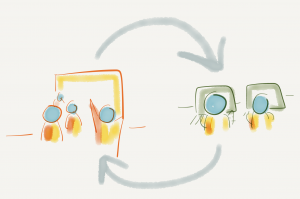
My lovely Liberating Structures (LS) community of practice has a monthly newsletter. December’s will be around LS online and as I started marking up their draft, I realized it would be a good idea to get my thinking/practices more clearly outlined rather than trying to “think out loud” and potentially make a mess of their draft!
What I’m laying out here could be extrapolated to other group processes, not just Liberating Structures. My goal is to describe how I think, talk and practice in online facilitation. I’m going to use the LS “Purpose to Practice” as the scaffold. The beauty of a scaffold is that it holds up an ever-evolving understanding of the practice, versus a static set of “best practices” or the like. This first version will stay at a pretty high level, and then it might be interesting to do some future posts digging deeper into each area.
Purpose

Why is this work important to me and the wider community?
Purpose exists on a couple of different levels here. At the highest, the
purpose of this post is to share learnings about how we transfer facilitation of offline group processes into an online space. In this particular instance, I’m focusing on LS and primarily synchronous online interactions using group meeting tools. My ultimate purpose is to use LS online so that people are easily and delightfully engaged and liberated to achieve their own purpose(s).
Purpose from an LS perspective – the integrity of an LS used online or offline – should be consistent with the structure and theoretically is not informed by the environment.
Purpose informs what structures people use, regardless of environment.
In practice, people use each LS in different ways. For example, the stated
purpose on the LS site guides us, but our ability to riff and improvise may surface other, unique purposes.
When thinking about the online environment, there may be more than one LS to choose in terms of what that structure enables (its purpose), but one of those options may be more suited to the online environment. For example, when the harvest of a process is important, an online environment makes it easy for everyone to type in and capture their input, faster and easier than a wall of sticky notes. The harvest is done by all, not by the facilitator. The data can be quickly organized, parsed and we can bring forth the best of what was produced.
People’s individual experience and practices using LS also vary. Some of us have favorites that we go to over and over. This may bias towards or away from using LS online because of our comfort of using a particular LS and how easy it is to transfer its use online.
Principles and Minimum Specifications
 What rules must we obey to achieve our purpose? What are the minimum specifications, things we must absolutely do/not do?
What rules must we obey to achieve our purpose? What are the minimum specifications, things we must absolutely do/not do?
Again, principles exists on different levels. There are my personal principles as a facilitator/participant which drive my practices. There are the principles that sit beneath Liberating Structures . (Or whatever processes you use.) There are the principles of the individuals and group involved. I am excluding my personal principles/generic facilitator principles and will mostly focus on principles that arise from the online environment and which inform minimum specifications and practices. The other levels are very rich areas for future exploration!
Here are my general principles for using LS online:
Practice with others. The online environment can be unkind to multitasking… (Min Spec: Find a co-facilitating friend)
Use the power of alternating individual, small and large group interaction. Don’t fall trap to top-down online meetings, especially since most technologies favor top-down. (Min spec: unless the group is very small, don’t stay in a large group the whole time – a.k.a “goat rodeo”)
When in doubt, keep things simple. From technology, to process – simplicity gives room for experimentation and emergence. For example, while we might rapidly restring our structures F2F, we may not always be as prepared to do that as quickly online without a deeper practice. From a tech perspective, we might keep our technology set simple. (Min spec: never introduce more than two new tools to a group. One is ever better!)
Be prepared to be surprised (and innovate, use plan b, etc!) Technology (and the supporting infrastructure like bandwidth and even electricity) are rarely under your control. (Min spec: stay cool! Have a backup plan. Set reasonable expectations.)
Position everything as an experiment and a chance to learn, even while focused on real and urgent purposes. Let go of thinking everything can and should be perfect. (Min spec: let go of the identity of an expert.)
People/Participants
 Who must be included to achieve our purpose?
Who must be included to achieve our purpose?
This one is much easier because there is little distinction between online and offline. The main benefit may be that online we might possibly include MORE people than we could if we were limited to a face to face interaction. In general, my overall facilitation principles drive me to include everyone who is engaged/impacted by the purpose to participate. Even if they are spread all across the globe. That is one of the driving strengths of doing things online, despite the challenges.
Structure
How will we organize to distribute control?
Traditional design and use of online meeting tools have centralized control to the person who has administrative control of the meeting software. Sometimes additional people can be given these “host” or “admin” roles, partially or fully. But the central design of these tools has prioritized control over emergence, theoretically to offer a more consistent experience. Liberating Structures, on the other hand, is designed to engage and unleash everyone. So it is super important to figure out how to hack these tools to distribute control. Here are three potential vectors for distributing control. I’m sure there are more. Ideas?
- Control can be distributed by handing off control of the software. I start by sharing my screen, now you can share yours. Here, why don’t you work on setting up the breakout groups while I review the process?
- Control can be explicitly shared by identifying and distributing /switching roles. I’ll facilitate the process, you work on the technology support. Everyone can take notes in the chat. Invite people into those roles early and often.
- Control can be distributed by facilitators being quiet for a while. Some of us facilitators have this urge to fill every second of air time. Silence can give others a chance to breathe, think, and then participate in a way that is easier for them. Facilitators, IT IS NOT ABOUT US!! This is also a practice.
Practices
 What are we going to do?
What are we going to do?
This is where it gets practical. It is also where it may be more useful to
describe practices through examples of how to use specific LS online. So I’ll start general, then we can dive into specifics in future posts.
For me there are two intersecting sets of practices: the process facilitation and the technology stewardship. I (along with John D. Smith and Etienne Wenger) have written extensively about technology stewardship. You can get the book (free!) on the Digital Habitats book site, and I will focus only on LS related facilitation and tech stewardship issues. You will also note how these are related to principles stated above!
- Don’t do this alone. Have one person focus on the technology stewardship issues while the other facilitates process. It can be devilishly hard to do both at one time. For example, individuals with tech problems need one on one private “back channel” assistance that doesn’t suck up the time and attention of the whole group. Setting up breakout rooms is best done with attention, not while multitasking with process instructions.
- Select and use technology to facilitate the large group/small group/individual levels of participation that are found in LS. For me the profound difference of using LS online and more traditional “web meetings” or “webinars” is that they enable peer to peer, multi-directional interaction versus being the object of a stream of content from one or few people.
- Use multiple modalities beyond voice. We humans pay less attention to verbal interactions when we aren’t facing each other. Video can help – a bit – but not resolve our lackadaisical listening skills. So important instructions (how to do a LS, the invitation, etc.) should also appear visually on a slide, whiteboard or chat room. Don’t underestimate adult’s ability to quickly forget the instructions as well, so make sure they are visible in breakouts. Use images, drawing tools – whatever it takes to create a closer cycle of information exchange and UNDERSTANDING.
- Keep technology choices as simple as possible. For example, if you pair the web meeting tool Zoom with Google Docs, it may seem really easy if you already have a Google Doc practice. For someone totally new to both, it may be enough to learn one tool at a time. For experts, pile it on! Just because we can use a ton of tools doesn’t mean we always SHOULD. A subset of this is “always keep an eye out for new tech” – the landscape is constantly evolving.
- Beware of the heaven/hell of harvesting online. Online tools make it easy for everyone to write/draw/contribute. When it comes to
sensemaking and harvesting, be careful of creating too much useless/never used content. Ask people to ruthlessly evaluate and harvest the best of what is created. - Don’t restrict yourself. Think through how you will use an LS online based on your purpose instead of slavishly following the instructions in a literal manner. Use your imagination and the strengths of the technology you are using rather than fighting the limitations. This is a great place to expand your LS repertoire. (Again, there should be a whole post on using the LS Matchmaker with an online perspective. Some of us have been trying to capture our current state of understanding of this.)
- Give most LS a bit more time online, especially when learning how to do them online. Don’t over-pack your sequence or “string” of structures. While I might do 3-5 in 90 minutes F2F, I’d say 3 online! To date, almost all the LS I’ve used online take more time the first time (sometimes a LOT more time). We get better over time, but if you are always working with new people, build in learning time. And in a perfect world, get the chance to do these together more than once. It gets richer and richer. Another perspective is spreading out a string over multiple, shorter online meetings. Most of us burn out after 90 minutes of full on attention online.
- Reflect on the similarities and differences of a structure/string online and offline. Chances are this will deepen your overall understanding and facilitation practice, and expand possibilities each time you reflect, learn, apply, and repeat! Better yet, reflect with your peers. Use What, So What, Now What? to debrief at every chance. Share your learnings with the Liberating Structures community
of practice on Slack.
Resources
- Liberating Structures site http://www.liberatingstructures.com
- Building an Online Liberating Structures 90 Minutes at a Time https://fullcirc.com/wp/2018/09/14/building-an-online-liberating-structures-practice-90-minutes-at-a-time/
- All my Liberating Structure blog posts https://fullcirc.com/wp/category/liberating-structures/
The next fun frontier – digital asynchronous LS. I’m going to attempt some kind of writing/Drawing Together experiment over the course of the Eurotour to see what happens. It might be a total mess.
That’s the spirit!